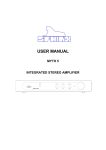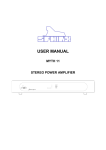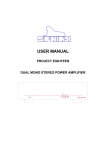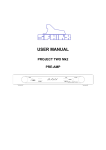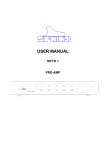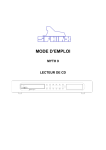Download USER MANUAL
Transcript
1. USER MANUAL PROJECT TEN INTEGRATED STEREO AMPLIFIER SPHINX Project Ten 1. UNPACKING................................................................................................................................. 3 2. SPHINX WARRANTY CARD......................................................................................................... 3 3. THE AMP AT A GLANCE ............................................................................................................. 4 Front panel ........................................................................................................................................... 4 Rear panel............................................................................................................................................. 5 4. INSTALLATION AND CONNECTIONS......................................................................................... 6 Installation............................................................................................................................................. 6 Connecting the mains cable................................................................................................................... 6 Audio connections ................................................................................................................................. 6 Connecting loudspeakers....................................................................................................................... 6 Connecting headphones ........................................................................................................................ 6 Connecting the inputs ............................................................................................................................ 7 Balanced ............................................................................................................................................. 7 Unbalanced ......................................................................................................................................... 7 Connecting a recorder ........................................................................................................................... 7 Connecting a turntable........................................................................................................................... 7 Balanced ............................................................................................................................................. 7 Unbalanced ......................................................................................................................................... 7 Connecting a CD player ......................................................................................................................... 7 Balanced ............................................................................................................................................. 7 Unbalanced ......................................................................................................................................... 7 Connecting a tuner ................................................................................................................................ 7 Connecting other signal sources ............................................................................................................ 7 Connecting the optical cables ................................................................................................................ 7 5. OPERATION ................................................................................................................................. 8 Power on ............................................................................................................................................... 8 Selecting an input .................................................................................................................................. 8 Tape Mon button ................................................................................................................................... 8 Adjusting the volume ............................................................................................................................. 8 Mute button ........................................................................................................................................... 8 Power off ............................................................................................................................................... 8 SPHINX REMOTE CONTROL .......................................................................................................... 9 Buttons.................................................................................................................................................. 9 Operation ............................................................................................................................................ 10 Selecting without switching .................................................................................................................. 10 Batteries .............................................................................................................................................. 10 Encountering problems... ..................................................................................................................... 10 CARE AND MAINTENANCE ........................................................................................................... 11 TECHNICAL SPECIFICATIONS ..................................................................................................... 11 2 SPHINX Congratulations with your purchase of the Sphinx Project Ten! You are now a member of an ever increasing group of quality conscious audiophiles using Sphinx products. We are very proud of the tradition connected to the SPHINX name especially concerning audio quality perfection. This manual will help you to gain a maximum amount of pleasure and quality from your new Sphinx Project Ten Integrated Stereo Amplifier. This integrated high end stereo amplifier is of exceptional quality. With exception of the balanced input section it is of discrete design throughout (no IC's are used). The pre-amp section is built around Dual F ET 's and the amplifier is DC-coupled from input to output. The two mono power amps (each channel is totally independent) use specially selected power F ET 's with an power bandwidth of over 20 MHz, a very fast slew rate and an unsurpassed phase linearity over the power bandwidth. The amplifiers therefore are very stable and can effortlessly drive every type and format of loudspeaker (even the most complex ones such as electrostatic and magnetostatic...) at maximum quality. All internal audio cabling is Siltech pure silver and the amp outputs are sent to the loudspeaker connectors via heavy duty, completely sealed goldplated relays. Project Ten 1. UNPACKING Before leaving the factory every Project Ten is subjected to stringent and extensive technical and exterior quality inspections. This ensures you will enjoy many years of high quality audio from a perfect-looking product. After unpacking your Project Ten we therefore recommend you carefully check it for any transport damage. In case of damage: please contact your Sphinx dealer immediately and retain all packing materials for possible proof of damage and possible claims. Even if the component is in perfect condition you still should keep the packing materials. If you need to transport your Project Ten at a later time it will be best protected by the original packing materials. 2. SPHINX WARRANTY CARD Please take this opportunity to fill out the enclosed warranty card now! Follow the instructions on the card or consult your dealer. Please send the card as soon as possible to the return address (within 14 days after purchase). To obtain the maximum quality from this integrated amp it is necessary to use it with top quality audio components. So preferably use it with other Sphinx components. Please read this manual carefully before you install or use the Project Ten. It is important to familiarise yourself with the special functions, operation and possibilities of the Sphinx Project Ten. Your local dealer will be able to answer any questions concerning other Sphinx audio components. 3 SPHINX Project Ten 3. THE AMP AT A GLANCE Front panel 1 3 5 6 7 8 10 2 4 9 1. VOLUME: With this motor controlled knob you may adjust the volume of the loudspeakers. The volume can be controlled manually or via the optional remote control. 5. CD: To select the CD input. 2. STANDBY: To switch the component on and off. When the component is 'off' (standby) this is indicated by the red LED. When the component is active the LED will be green. 8. LINE 2: To select the LINE 2 input (cinch or balanced). 3. Sensor window for the IR signal from the remote control 4. MUTE: Press this button to temporarily mute the sound. The red LED will light. 6. TUNER: To select the TUNER input. 7. LINE 1: To select the LINE 1 input. 9. TAPE MON: To select the TAPE IN input. As soon as you have pressed one of the buttons 5. to 9. the corresponding red LED next to it will light. 10. PHONES: To connect dynamic stereo headphones. 4 SPHINX Project Ten Rear panel 14 20 11 12 13 15 16 11. ON/OFF: This is the mains power switch. 12. Fuse holder: Contains a fuse (3.15 A slow). 13. AC Power: Connect the mains cable to a mains power outlet (100 - 240 VAC). 14. CONTROL OUT: To connect the optical cable going to another Sphinx components. 15. RIGHT OUTPUT: To connect the cable from the right loudspeaker: red + white 16. LEFT OUTPUT: To connect the cable from the left loudspeaker: red + white 17. Manufacturers label: This shows important data for the component such as serial number and mains power voltage. 17 18 19 21 22 23 24 25 26 18. BALANCED LINE 2 RIGHT: To connect the XLR signal cable (balanced cable) from the right output of the signal source for input 2. 19. BALANCED LINE 2 LEFT: To connect the XLR signal cable (balanced cable) from the left output of the signal source for input 2. 20. CINCH/BALANCED: This switch is to select the input connector for LINE 2: out LINE 2 (cinch) in BALANCED LINE 2 21. LINE 2: To connect the cinch signal cable from the signal source for LINE 2. 22. LINE 1: To connect the cinch signal cable from the signal source for LINE 1. 23. TUNER: To connect the cinch signal cable from the tuner. 24. CD: To connect the cinch signal cable from the CD player. 25. TAPE IN: Connect this input to the output of the recorder. 26. TAPE OUT: Connect this output to the input of the recorder. 5 SPHINX Project Ten 4. INSTALLATION AND CONNECTIONS Installation Make sure you place the Project Ten on a stable and sturdy support, it weighs more than 12 kg! The Project Ten will become warm so correct placement is critical. Do not position it on top of or close to other heat radiating equipment (such as other power amps) or in direct sunlight. Please ensure unrestricted ventilation around the component. If you need to use the amp in a closed cabinet or on a bookshelf you absolutely should provide unrestricted ventilation around the component. To prevent any possible interference keep power supply cables away from all audio cables. If all these conditions are met the Project Ten shall perform to the extremely high standards it is designed for. Connecting the mains cable Before you connect the cable please check whether the mains voltage indicated on the manufacturers label on the rear panel is the same as your local mains voltage. If not: please contact your dealer and do not connect the component to the mains. You switch the amp on or off with the ST ANDBY button. This way the electronic circuits will be kept at optimum working temperature so you can enjoy maximum audio quality immediately after switchingon. On top of that it significantly increases the life span of the component. Connect the mains cable after you have connected all other components in the system and have double-checked all connections. Audio connections Before you start connecting equipment it is always wise to check whether all mains power cables of all components are disconnected from the mains outlets! This will prevent any damage to the loudspeakers and amplifiers caused by incorrect wiring or settings. Make sure you connect L and R properly. Most cinch cables use red for the right channel and white or black for left. All cinch connectors on the Project Ten's rear panel have a red centre for the right channel and a white one for the left channel. The XLR connectors are marked RIGHT and LEFT. When making the connections please refer to the descriptions for parts 11. up to 26. on page 5. Connecting loudspeakers We recommend using a double pair of cables if this is possible with the loudspeakers used (one pair for the highs and another for the lows). In most cases you will hear a substantial improvement in the sound quality (but: be careful to prevent shorted connections). Your dealer can recommend the best cables and connection methods. Connect the red RIGHT OUTPUT terminal (15.) to the red or '+' terminal of the right loudspeaker. Connect the black RIGHT OUTPUT terminal (15.) to the black or '—' terminal of the right loudspeaker. Connect the left loudspeaker in the same way to the LEFT OUTPUT terminals (16.) When using unterminated cables please check carefully if there are no 'loose ends' cause a short between the '+' and the '—' of the terminals on amp and loudspeakers! Connecting headphones You can connect normal dynamic stereo headphones to the PHONES jack (10.). The output has more than enough power to drive even the most demanding headphones. You can control the level with the VOLUME control (1.). The MUTE function (4.) does not work for the headphones. Note: The loudspeakers are not automatically deactivated when you connect headphones. So you may leave the headphones permanently connected. 6 SPHINX Project Ten Connecting the inputs Connecting a CD player The amp has one balanced and five unbalanced inputs. The CD player may be connected in two ways. Balanced Connect the balanced output of a CD player to BALANCED LINE 2 (18. + 19.). Use the BALANCED LINE 2 to connect the balanced outputs of other signal sources (tuner, CD player, etc.). You select this input by pressing the CINCH/BALANCED switch the rear panel (20.). The unbalanced LINE 2 input will be disconnected. Unbalanced The unbalanced CD TUNER TAPE IN LINE 1 and LINE 2 line inputs are: for a CD player, for a tuner, for a recorder, for any unbalanced line signal. Connecting a recorder Connect the input of the recorder to the TAPE OUT output (26.) Any input signal selected with buttons 5., 6., 7. or 8. and which you will hear via the loudspeakers is also sent to this output. Connect the output of the recorder to the TAPE IN input (25.) Connecting a turntable There is no specific RIAA phono-input. When using a turntable you should pre-amplify the signal with a separate phono pre-amp (or pre-pre-amp). The turntable may be connected in two ways. Balanced Connect the balanced output of a phono pre-amp to BALANCED LINE 2 (18. + 19.). Unbalanced Balanced Unbalanced Connect the unbalanced output of a CD player to the CD input (24.). You may connect the CD player balanced and unbalanced simultaneously! Or you may use two different CD players. Connecting a tuner Connect the unbalanced output of a tuner to the TUNER input (23.). If applicable you may connect the tuner's balanced outputs to BALANCED LINE 2 (if not in use by another component)! Connecting other signal sources LINE 1 and LINE 2 are available for any other signal sources. Connecting the optical cables The Project Ten has a CONTROL OUT optical connector so it can remotely switch another Sphinx component to stand-by. When the CONTROL IN of a component is connected to the CONTROL OUT of the Project Ten with an optical cable you do not have to use that component's ON/OFF switch. As soon as the Project Ten is selected to stand-by the other component is also selected to stand-by. Ensure proper connection of the optical cables (from CONTROL OUT to CONTROL IN), otherwise the LED next to the ST ANDBY button on the front panel may remain green although the stand-by mode is activated. Connect the unbalanced output of a phono pre-amp to one of the cinch inputs LINE 1 or LINE 2. You may connect the phono pre-amp balanced and unbalanced simultaneously! Or you may use two different pre-amps. 7 SPHINX 5. OPERATION After you have finished connecting all components, you can power on the Project Ten. Connect the mains cable to a mains outlet. Switch the Project Ten on with the ON/OFF switch (11.) on the rear panel. The LED next to the ST ANDBY button will be red. The Project Ten is now in stand-by function. From now on you should switch the power amp on and off with the ST ANDBY button (1.) on the front panel That way all circuits will remain at optimum operating temperatures and the audio quality will be at 100% immediately after switching on. On top of that it significantly increases the life span of the component. Power on You switch the Project Ten on with the ST ANDBY button. The LED will turn to green. Selecting an input You select the input with one of the buttons 5. to 9. (right-hand side on front panel). As soon as you have selected an input, the red LED next to the button will illuminate. CD : To select the CD input. TUNER : To select the TUNER input. LINE 1 : To select the LINE 1 input. LINE 2 : To select the LINE 2 input. When using LINE 2, you should have selected the input you have used with the CINCH/BALANCED switch (20.) on the rear panel: unbalanced (21.) or balanced (18. + 19.). Project Ten Tape Mon button Pressing the TAPE MON button in the front panel (9.) selects the TAPE IN input. After you press PLAY on the recorder you will hear the recorded signal. But if you record a tape this button lets you compare the input signal (as selected with button 5., 6., 7. or 8.) to the signal from the recorder: IN (LED red) signal from tape OUT (LED off) signal from selected input When using a 3-head recorder you are thus able to compare the original signal with the actual recorded signal (you'll hear the 'off-tape' signal which might be slightly delayed). Adjusting the volume With the large VOLUME control (1.) you can adjust the sound level from the loudspeakers. This volume control is motor controlled. So even if you adjust the volume on the remote control the knob will automatically turn. The position of the knob therefore always correctly indicates the set volume. Mute button The MUTE button (4.) temporarily mutes the sound from the loudspeakers: the red LED will light. Another press on the button un-mutes the sound, the LED extinguishes. You may also use this button when you listen on headphones and would like to switch the loudspeakers off. The mute function has no influence on the signal to the headphones. This function can also be controlled via the remote control. Power off You switch the Project Ten off (to stand-by) with the ST ANDBY button (2.). 8 SPHINX Project Ten SPHINX REMOTE CONTROL This single Sphinx Remote Control lets you control all functions: not only of the Project Ten, but of all other Sphinx equipment. Only the following buttons and indications of the Remote apply to the Project Ten (the others will not function): Buttons 1. PRE-AMP: To select the amp. All buttons pressed hereafter will only control the amp functions. The buttons TUNER and CD will have no effect on the amp. 2. STANDBY: Use this red button to switch the Project Ten to stand-by. 3. : Pressing this green button mutes the outputs (temporarily) and you will not hear any sound. The red LED will be illum inated. Another press on this button un-mutes the outputs 4. TAPE/MONITOR: Use this button to select the Tape IN input. Pressing this button has the same effect as pressing the TAPE button on the front panel. Note: The LED of the selected input (see 5.) will remain illum inated. 5. 1 - 4: To select inputs CD to Line 2 . 1 CD 2 Tuner 3 Line1 4 Line 2 6. ñ button: Pressing this button has the same effect as clockwise rotating the VOLUME control on the front panel. You will increase the volume. 7. ò button: Pressing this button has the same effect as anti-clockwise rotating the VOLUME control on the front panel. You will decrease the volume. 9 SPHINX Project Ten Encountering problems... Operation The Sphinx Remote is used for several different models and can therefore transmit different control codes, depending on which model has been selected with the select buttons (1.). Important: Always press the PRE-AMP button before you send a command (even if you only have one Sphinx component). If not it is possible that although the Remote will send a signal (LED blinks) nothing happens because the transmitted signal is not 'recognised' by the component. Indoors the Remote may be used up to a distance of 7 meter, provided there is no strong sunlight in the room and if you aim the Remote at the component. Always aim the Remote straight at the front panel of the component, the maximum offset angle is 30°. Remote Control does not work Wrong component selected Select the correct one Distance to component exceeds 7m Use remote at closer range Angle between Remote and component exceeds ±30° Decrease angle Sensor window on front dirty Clean window Batteries empty or incorrectly placed use new batteries or replace the old correctly Strong (sun)light in room Shade off Component is not switched on (!) Switch it on Selecting without switching Suppose for instance that you would like to select the Tuner to Radio 4 without interrupting the CD playback. In that case you momentarily depress (not longer than 0.5 sec) the 'TUNER' button and the '4' button. The same procedure is used for the other system components How to operate the Remote Control with the different Sphinx components will be explained in the corresponding User Manual of each component. Component reacts differently than expected or not at all Wrong component selected Select the correct one Component or remote does not function Check component with it's original remote Batteries of remote empty Use new batteries Batteries The four batteries have a life span of approx. one year during normal use, but shorter when used more intensely. Replacement batteries: 1.5 V, model AAA . You may also use rechargeable 1.5 V batteries. Do not leave the battery compartment empty for more than 30 minutes or else all information in memory will be erased! Note: Position the new batteries exactly as shown in the illustration at the bottom of the battery compartment, otherwise the Remote will not function! 10 SPHINX Project Ten CARE AND MAINTENANCE Clean the exterior with a soft, lint-free, anti-static cloth. Do not use force while wiping the surface. To remove difficult stains use a few drops of detergent on a moist cloth, sweep carefully and wipe dry afterwards. If some scratching occurs, please first consult your Sphinx dealer. He can give you advice about possible solutions. Do not use polishing or cleaning agents: they may damage the sensitive acrylic finish. Do not use aerosol cleaning agents. Most contain solvents which might actively react and damage the acrylic finish. TECHNICAL SPECIFICATIONS Bandwidth Phase response error Gain Minimum Power Output (1 - 20.000 Hz) Output voltage / current, max. T HD+N (IHF-A) IMD S/N ratio (IHF-A) Channel separation Slew rate Damping factor 0 - 60,000 Hz (+0/-3 dB with RF input filter) <15° (from 0 - 20,000 Hz) 21 dB max. >2x 80 W into 8 Ω (19.0 dBW), THD <0.01% >2x 120 W into 4 Ω (20.8 dBW), THD <0.02% >2x 160 W into 2 Ω (22.0 dBW), THD <0.02% 34 V / 20 A <0.01% (80 W into 8 Ω ) <0.03% >106 Db >80 dB (1 - 20,000 Hz) >25 V/µs >200 (1 - 20,000 Hz) Inputs XLR, balanced cinch, unbalanced level, nominal impedance 1x Line 2 1x Line 2, 1x Line 1, 1x CD, 1x Tuner, 1x Tape 0.15 V (-16.5 dBV) for 60 W into 8 Ω 20 kΩ (3 kΩ balanced) Outputs cinch level headphones clamp 1x Tape 10 V max. (20 dBV) (1 - 20,000 Hz, THD <0.01%) 1x 6.3 mm stereo jack, adjustable level 1x loudspeaker L, 1x loudspeaker R Supply capacitance Power consumption Dimensions (h x w x d) Weight 54,400 µF per channel 480 W max. (57.5 W standby) 110 x 482 x 330 mm 12 kg This unit conforms to the EMC interference regulations from the EU and to the CE standards. This unit complies with safety regulation VDE 0860 and thus with international safety regulation IEC 65. Technical specifications can be changed by SPHINX without prior notice if technical developments make this necessary. ©1998 Audioscript BV 11











